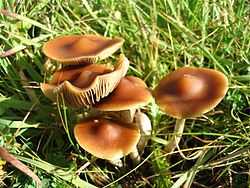Psilocybe subaeruginosa
| Psilocybe subaeruginosa | |
|---|---|
 | |
| Scientific classification | |
| Kingdom: | Fungi |
| Division: | Basidiomycota |
| Class: | Agaricomycetes |
| Order: | Agaricales |
| Family: | Strophariaceae |
| Genus: | Psilocybe |
| Species: | P. subaeruginosa |
| Binomial name | |
| Psilocybe subaeruginosa Cleland | |
| Psilocybe subaeruginosa | |
|---|---|
|
| |
| gills on hymenium | |
|
cap is conical or umbonate | |
|
hymenium is adnate or adnexed | |
| stipe is bare | |
| spore print is purple-brown | |
| ecology is saprotrophic | |
| edibility: psychoactive | |
Psilocybe subaeruginosa Cleland is an extremely potent psychedelic mushroom of Australasia, which has psilocybin and psilocin as its main active compounds.
First described in 1927 by Australian mycologist John Burton Cleland,[1] it was previously placed in the section Cyanescens.[2] Cyanescens has since been deprecated as a section and so Psilocybe subaeruginosa now falls under the section Semilanceatae.[3]
Studies of comparative morphology, isozyme analysis and mating compatibility approaches have shown that P. australiana, P. eucalypta and P. tasmaniana are synonyms of this species.[2] However, further studies have rejected the proposed synonymy with P. tasmaniana based on differences in habitat and microscopic characters.[4]
Description
- The cap is 1–6 cm in diameter, conical to convex, tan brown, hygrophanous, margin striate when moist, uplifting in age, and often with a slight umbo. It bruises bluish where damaged.
- The gills are crowded, cream color when young, violet brown in age, with adnate to adnexed attachment.
- The spore print is dark violet brown.
- The stipe is 4.5 to 22 cm long, 0.2 to 0.5 cm thick, white, bruising blue where damaged, finely striate, and equal to slightly enlarged near the base. A white cortinate partial veil soon disappears and often leaves traces in the upper stem.
- The taste and odor are farinaceous.
- The cheilocystidia are 17 - 29 x 5.5 - 11, hyaline, fusoid-ventricose, subpyriform or mucronate, often with an elongated neck at the apex which is 2 - 4.5 µm. The pleurocystidia measure 22 - 47 x 6 - 16 µm and is shaped like the cheilocystidia and also hyaline. The spores are smooth, subellipsoid, with an apical germ pore, measuring (10) 13.2 - 14.3 (15.4) x 6.6 - 7.7 x 6 - 7.5 µm.[5]
-

Psilocybe subaeruginosa cheilocystidia 600x
-

Psilocybe subaeruginosa pleurocystidia 600x
-

Psilocybe subaeruginosa spores 1000x
Distribution and habitat
Psilocybe subaeruginosa grows solitary to gregarious from wood such as wood chips in urban areas, pine tree plantations and woody debris in forests and gardens.[6] It is common in southern parts of Australia[2] and New Zealand[4] from April to August.[7]
Alkaloid content
Psilocybin has been isolated from this species in 0.45% yield.[8] In the same study, psilocin was not detectable with the analytical methods used (chromatographic separation and UV spectroscopy), and was estimated to be present at less than 1% of the psilocybin content.
In contrast to this, results from a M.App.Sci thesis, which were never published in the peer-reviewed literature, showed that Psilocybe subaeruginosa collected in Victoria, Australia contained up to 1.93% psilocybin.[9] Given that Psilocybe azurescens contains up to 1.8% psilocybin[citation needed], some populations of P. subaeruginosa could be even more potent.
Gallery
All of the images below are of P. subaeruginosa.
References
- ↑ Cleland, J.; Burton, J. (1927). "Australian fungi: notes and descriptions—No. 6". Transactions and Proceedings of the Royal Society of South Australia 51: 298–306.
- ↑ 2.0 2.1 2.2 Chang, Y.S.; Mills, A.K. (1992). "Reexamination of Psilocybe subaeruginosa and related species with comparative morphology, isozymes and mating compatibility studies". Mycological Research 96 (6): 429–441. doi:10.1016/S0953-7562(09)81087-3.
- ↑ Alan Rockefeller & Danny Newman. "Name: Psilocybe sect. Cyanescens". Mushroom Observer. Retrieved 2012-08-03.
- ↑ 4.0 4.1 Johnston, P.R.; Buchanan, P.K. (1995). "The genus Psilocybe (Agaricales) in New Zealand". New Zealand Journal of Botany 33 (3): 379–388. doi:10.1080/0028825X.1995.10412964.

- ↑ Guzmán, Gastón (1983). The Genus Psilocybe. Nova Hedwigia. ISBN 3-7682-5474-7.
- ↑ Stamets, Paul (1996). Psilocybin Mushrooms of the World. Berkeley: Ten Speed Press. ISBN 0-9610798-0-0.
- ↑ Grgurinovic, Cheryl (1997). Larger Fungi of South Australia. Adelaide: Botanic Gardens of Adelaide and State Herbarium and Flora and Fauna of South Australia Handbooks Committee. ISBN 0-7308-0737-1.
- ↑ Picker, J.; Richards, R.W. (1970). "Occurrence of psychomimetic agent psilocybin in an Australian agaric, Psilocybe subaeruginosa" (PDF). Australian Journal of Chemistry 23 (4): 853–855. doi:10.1071/CH9700853.
- ↑ Perkal, Michael (1981). Analysis of hallucinogens in psilocybe-type mushrooms. Caulfield East, Victoria, Australia: Caulfield Institute of Technology.






